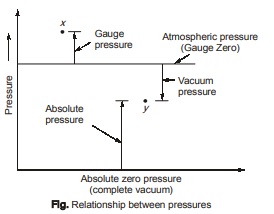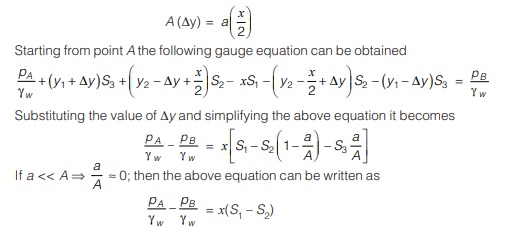Types of Pressure
3 Types of Pressure
(1) Atmospheric Pressure : The pressure exerted by atmospheric air normally upon all surfaces with which it is  in contact, is known as atmospheric pressure.
in contact, is known as atmospheric pressure.
(2) Absolute Pressure : The pressure measured above absolute zero (or complete vacuum) is known as absolute pressure.
(3) Gauge Pressure : The pressure measured above or below the atmospheric pressure is known as gauge pressure. Thus, gauge pressure can be negative or positive. Its value will be negative if value of the absolute pressure is less than atmospheric pressure & vice-versa.
If the pressure of a fluid is below atmospheric pressure, it is designated as vacuum pressure (or vacuum pressure suction pressure or negative gauge pressure); and its gauge value is the amount by which it is below that of the atmospheric pressure.
Absolute pressure = Atmospheric pressure + Gauge pressure
Absolute pressure = Atmospheric pressure – Vacuum pressure
Pressures are assumed to be gauge pressures unless specifically designated as absolute. For e.g., 100 kPa (abs) would refer to absolute pressure.
Piezometer
- A piezometer is the simplest form of manometer which can be used for measuring moderate pressures of liquids.
- It consists of a glass tube inserted in the wall of a pipe or a vessel, containing a liquid whose pressure is to be measured. The tube extends vertically upward to such a height that liquid can freely rise in it without overflowing.
- The pressure at any point in the liquid is indicated by the height of the liquid in the tube above that point.
The pressure is measured correspond to gauge pressure. To find absolute pressure at the point, atmospheric pressure is to be added to the gauge pressure. - Location of the point of insertion of a piezometer makes no difference in reading.
- To avoid the effect of capillarity, pipe diameter of piezometric tube should be sufficiently large.
- In the given figures, pressure at point A is given by
P = ρgh,
where h = rise of liquid in piezometer
Limitations:
- Cannot be used when large pressure in lighter liquids is to be measured.
- Gas pressure cannot be measured, because gas forms no free atmospheric surface.
- It can’t measure the negative gauge pressure.
Micromanometers
- For the measurement of very small pressure differences, or for the measurement of pressure differences with high precision, special forms of manometer called as micromanometer are uses.
- Micromanometers either magnify the reading or permit the readings to be observed with greater accuracy.
- These manometers contain two manometric liquids of different specific gravities and immiscible with each other and with the fluid for which the pressure difference is to be measured.
- Let the pressure at A is greater than at B (pA> pB) then level of the lighter manometric liquid will fall in the left basin and rise in the right basin by the same amount ∆y. Similarly the level of the heavier manometric liquid will fall in the left limb to point E and rise in the right limb to point F. If A and a are the cross – sectional areas of the basin and the tube respectively, then since the volume of the liquid displaced in each basin is equal to the volume of the liquid displaced in each limb of the tube, then

<< Previous | Next >>
Must Read: What is Fluid Mechanics?

